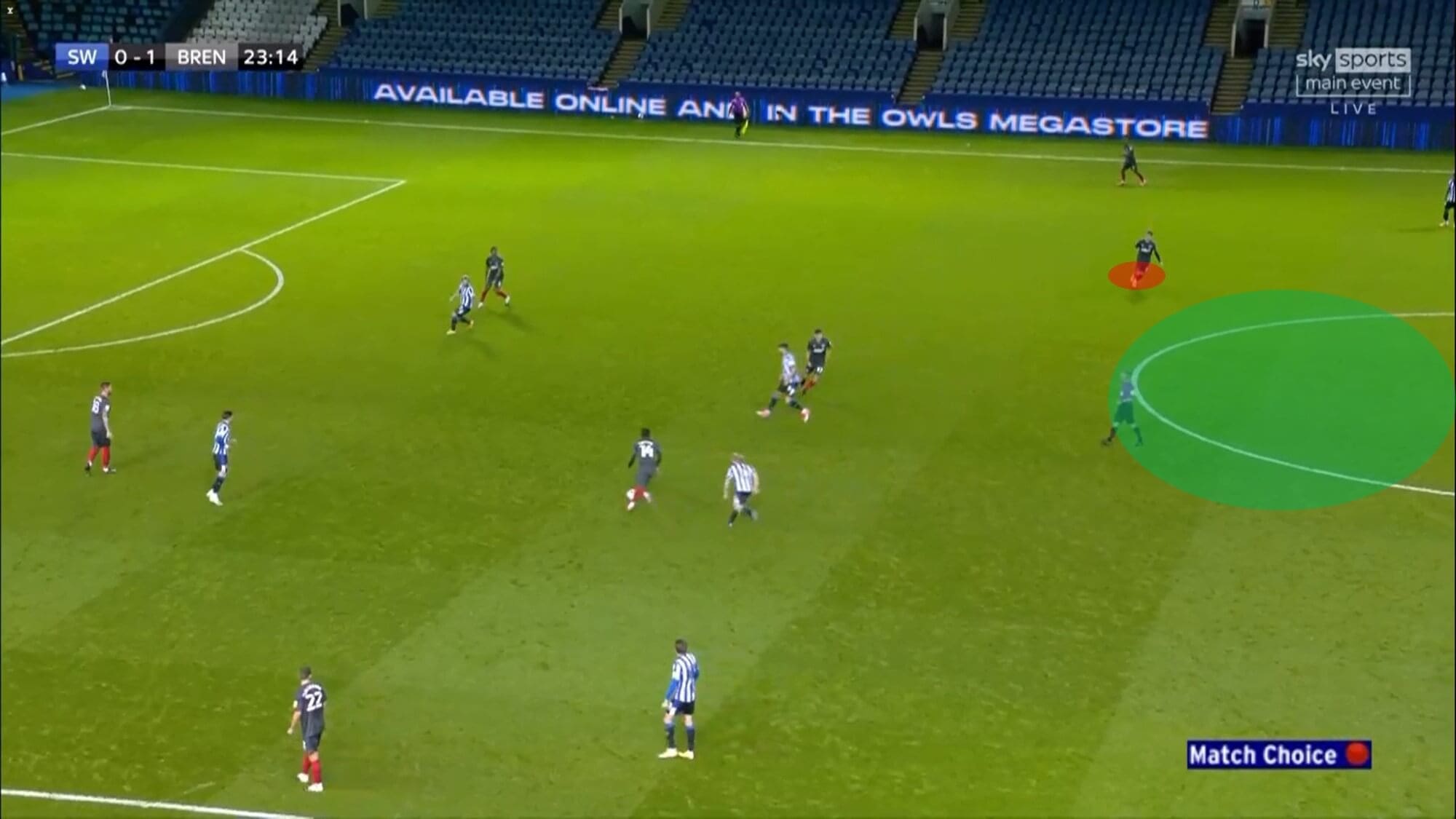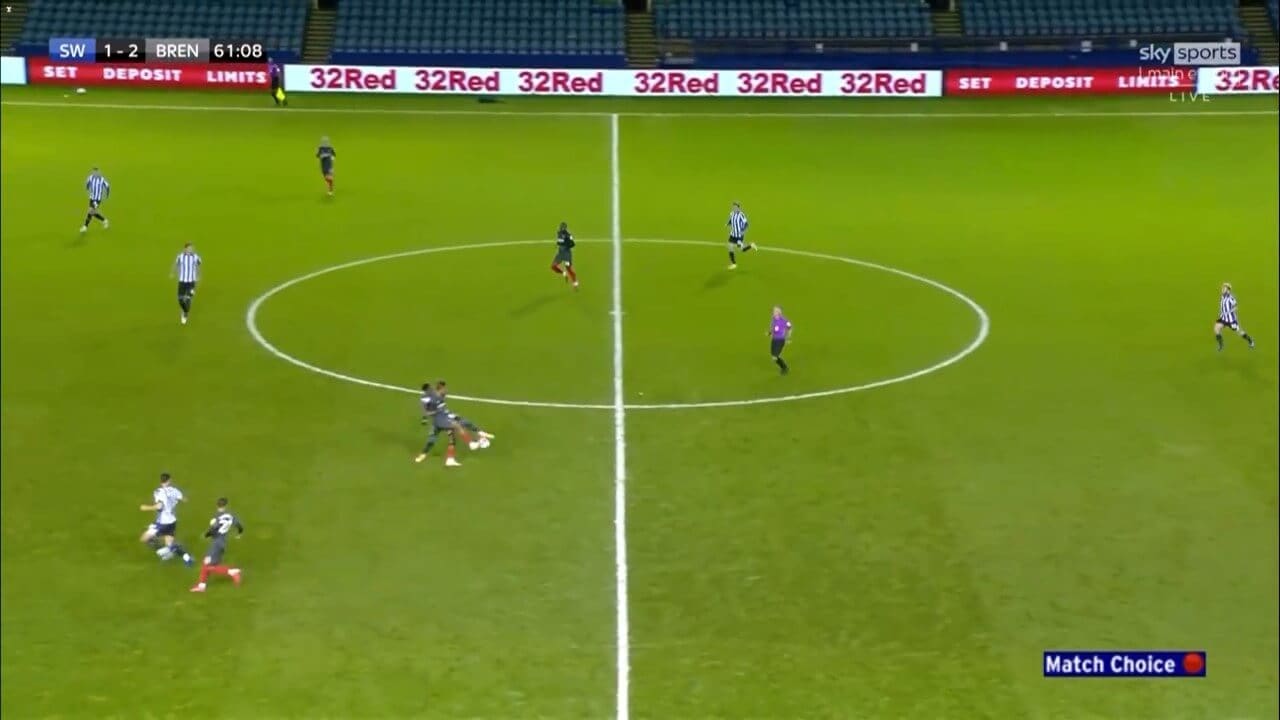Sheffield Wednesday sunk to their second league defeat of the season, going down to a much-fancied Brentford side at Hillsborough. The Bees ran out 2-1 winners, and they took the lead after just seven minutes when Ivan Toney reacted quickest to a rebound from Henrick Dalsgaard’s shot. Wednesday found themselves level later on in the first half after Callum Paterson headed in from a scrumptious Kadeem Harris cross. However, parity wasn’t restored for long because just five minutes after Paterson opened his Owls’ account, Toney claimed his second. The former Peterborough United man headed home a Vitaly Janelt corner. Garry Monk’s side huffed and puffed, but they couldn’t find their way through a sturdy Brentford backline.
This tactical analysis will examine the tactics used by both sides in the EFL Championship clash.

Line-ups
Garry Monk opted to go with a 3-4-1-2 system. Cameron Dawson kept his shirt in goal, playing behind central defenders Moses Odubajo, Aden Flint and Joost Van Aken. Kadeem Harris and Adam Reach started at wing-back, with Alex Hunt and Barry Bannan playing in central midfield. Callum Paterson played in an advanced midfield role, playing behind strikers Josh Windass and Jack Marriott.

Brentford boss Thomas Frank opted for his tried and tested 4-3-3 formation. Rumoured Arsenal target David Raya started between the sticks, with central defenders Pontus Jansson and Ethan Pinnock in front of them. Rico Henry and Henrik Dalsgaard started at full-back. Vitaly Janelt played in a holding midfield role, with Josh Da Silva and Matias Jensen either side of him. Saman Ghoddos started on the left-wing after Said Benrahma left to join West Ham. Bryan Mbuemo started on the opposite flank, with Ivan Toney leading the line.
Wednesday’s pressing and how Brentford overcame it
Sheffield Wednesday usually like to play a midblock, and they’re usually happy to allow the opposing central defenders time on the ball. Instead of jumping out to press them, the Owls’ front two are usually conservative: focusing on stopping ball progression into midfielders. The attacking midfielder usually joins the front two in the initial press, man-marking the opponent’s deepest midfielder. In the image below, you can see that the Owls set up like this against Brentford.

Paterson man marked Janelt, so it was difficult for the Bees to play through him as the pivot. His central position allowed Marriott and Windass (circled in blue) to press from wider positions, meaning that they were blocking the passing lanes into Brentford’s advanced midfielders in the half-spaces. They were backed up by Bannan and Hunt, who were within a short distance of Brentford’s more advanced midfielders in case the ball got to them.
However, the away side managed to solve this problem by rotating the midfield three, which dragged Paterson away from the pivot position and created space for one of the advanced midfielders to drop in and receive the ball deep. In the image below, Jensen is the Bees’ deepest midfielder. Paterson realises this, so he goes to mark him. Jensen then makes a run into a wider position away from the goal, which drags Paterson away from the middle of the pitch.

Da Silva then dropped deep into a position to receive possession.

Another way Brentford managed to penetrate through the Owls’ press was by manipulating the pressing positions of Wednesday’s front two. In the image below, they work the ball back to David Raya, with both central defenders splitting into wider positions.

The strikers were trying to keep Brentford’s attacking midfielders in their cover shadow, so it was hard for the defenders to play the ball through to them. However, they also wanted to ensure that they were putting sufficient pressure on the centre-backs to make it more difficult to play a pass round them or through them. As Jansson (out of shot) comes wider, Windass (left of the front two) takes a couple of steps to his left. It’s only a subtle movement, but this means that the passing lane is now open for Raya to find Jensen, which takes Wednesday’s first line of pressure out of the game.
The Owls didn’t help themselves at times though. Sometimes they tried to press quite high, but they did so in a disjointed fashion. The image below is an example of Wednesday’s disjointed press.

Wednesday attempted to go man-for-man in the middle third, but they did so with a numerical disadvantage as Alex Hunt was deeper than his midfield teammates. As you can see, Jensen is in acres of space. Da Silva manages to find a pass into his feet, and he receives the ball in space: taking Bannan and Paterson out of the game. Now, as the ball has been worked past Bannan and Paterson, Saman Ghoddos has drifted infield and he’s in a lot of space to receive from Jensen. Hunt tries to press him, but because the Owls’ midfield didn’t press as a unit, Brentford were able to pick them off and find the spare man in space.

Due to the threat of Toney running in behind and the lack of pressure on the ball, Wednesday’s backline retreats into a deeper position. This gives Ghoddos even more space to run into and time on the ball.
Ivan Toney
Brentford’s final third play was significantly better than Wednesday’s, and a lot of that was down to the performance of the league’s top scorer Ivan Toney. The summer recruit has hit the ground running, and as well as scoring twice he was a constant thorn in Wednesday’s side. When Brentford needed to go more direct, his hold-up play was excellent. In the second half when his team were under the cosh at times, he was constantly an outlet who helped relieve pressure on his side. In the image below, a long ball is going up to Toney in the second half.

He uses his sublime first touch to bring the ball under control, and he cleverly places his body between the ball and Owls’ defender Moses Odubajo. This meant that Odubajo would have to go through him and commit a foul to win the ball, which he did. Toney’s neat control and clever body positioning won his side a free-kick.
The former Newcastle man also displayed his ability to find space and receive the ball to feet. He constantly threatened by running in behind, but he also knew when to drop off and ask for the ball to feet. In the image below, Toney drops off slightly to receive the ball from centre-back Pontus Jansson.

He then plays an excellent first-time flick to Ghoddos in behind. Toney combines real physical strength with excellent technical ability, and his knack of bringing others into play with classy one-touch layoffs make him a top all-round striker.
Brentford take advantage of a set-piece
The analysis will now focus on the set piece that resulted in Brentford’s second goal. Brentford underloaded the front post area to create a one versus one situation, with Toney wrestling Moses Odubajo. They aimed to leave that area as unoccupied as possible, which resulted in most of their attacking players positioning themselves towards the back post area. This included the two centre-backs, who dragged Van Aken and Flint away from the front post area.

Jensen also stands near the corner for a potential short pass. By doing that, he’s drawn both Marriott and Bannan out of the box, because if only one of them stood in that position then they’d easily be able to play the ball through them if they played it short.
The lack of players in the front zone means that Toney has a clear run to attack the ball from deep, meaning it’s easier to generate power in the header. His deeper starting position gives him more time to generate momentum in his run, and he’s further away from any physical challenge by Windass, who is zonally marking the front post area. Toney connects with the ball on the edge of the six-yard box, wrestling Odubajo away from him and heading past Cameron Dawson.

Sheffield Wednesday’s attacking play
Wednesday’s attacking play certainly lacked a cutting edge. Monk’s side created an overall xG of 0.28, compared to Brentford’s 1.65. Creativity has been a problem for an Owls side whose success so far this campaign has come from solid defensive foundations. Their focus wasn’t on playing out of the back: Wednesday often bypassed the midfield by using the passing range of Bannan and Van Aken to distribute wide. In the image below, it’s difficult for Wednesday to play out from the back as Brentford press with a front three, meaning there’s no numerical advantage in the initial build-up phase.

There aren’t any Owls players available for the short pass, so Van Aken plays a cross-field ball into the space behind Brentford left-back Rico Henry. Henry is forced to put the ball behind, under pressure from wing-back Kadeem Harris who had retained his width to stretch Brentford horizontally.
On the other side, Adam Reach also looked to keep his width. In the next image, he receives a cross-field pass from Bannan.

By taking up this position, he dragged Brentford right-back Henrik Dalsgaard wide, which created a gap between him and the right-sided centre-back. Windass could then look to run the channel and exploit that gap.
The Owls did manage to work the ball into decent areas, but their final delivery was well below par. They didn’t manage to convert territory and pressure into clear goalscoring opportunities because of this. In the image below, Reach manages to hit this cross over the top of everybody in the box. He just needed to deliver the ball between the Wednesday striker Jordan Rhodes and David Raya.

Brentford were happy to sit deep whilst they were defending. The backline was fairly happy for crosses to come into their box because the quality was so poor and easy to defend.

Conclusion
Garry Monk set his team a target to be on a positive points tally by the end of the week, but defeat to the Bees means that won’t be possible. The Owls still sit on minus four points. Nobody can fault their fighting spirit in the Brentford clash, but they just lacked quality and cutting edge in the final third. That result takes Brentford up to seventh in what is still an embryonic Championship table.






Comments